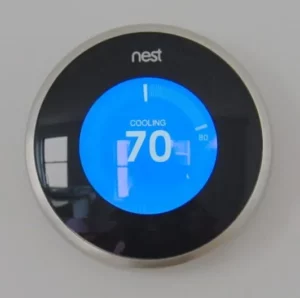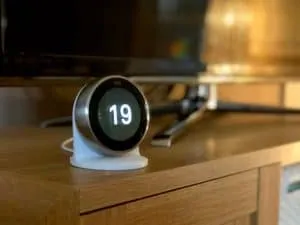Recently, I moved to a new place that had an outdated thermostat relying on pneumatics. Eager for an upgrade, I decided to install a Smart Thermostat, and after some research, I chose the Nest Smart Thermostat for its extensive functionality and minimal rewiring requirements. The installation went smoothly, and I was delighted to control my thermostat remotely from my phone.
However, a few weeks later, I encountered a problem when my AC stopped working, and the Nest Thermostat displayed a frustrating “Delayed” message. Determined to find a solution, I turned to the internet to understand the issue better and figure out how to resolve it. After gathering all the necessary information, I compiled my findings into a comprehensive article to help others facing a similar problem.
In short, to fix the Nest Thermostat Delayed Message issue, I discovered that using the Ohmkat C-Wire adapter was the solution. By attaching this adapter to the thermostat, the underpowered situation causing the “Delayed” Message is resolved. This not only restores the proper functionality of the thermostat but also ensures smooth operation without any delays.
With the Ohmkat C-Wire adapter in place, my Nest Thermostat regained its full power, and I no longer experienced any delays or issues with my AC. It’s rewarding to find practical solutions to technical problems, and I hope my article helps others facing the same inconvenience with their Nest Smart Thermostats.
Why Nest Thermostat Displays Delayed Message?
In summary, the “Delayed” message on the Nest Thermostat occurs due to a power shortage or being underpowered. Despite being connected to electricity, the Nest Thermostat doesn’t solely rely on power lines; it features an internal rechargeable Lithium-Ion battery that recharges itself from the HVAC system.

However, the power drain from the thermostat, driven by various functions like Wi-Fi, motion detection, display, etc., can sometimes exceed the power drawn, resulting in a deficiency. The available power is divided between recharging the thermostat’s battery and supplying the connected HVAC system, including the furnace, air conditioner, heat pump, and fans.
When the power input is insufficient, this distribution is greatly affected. As a consequence, the Nest thermostat’s battery and other HVAC components can become underpowered. This leads to erratic operation, such as random on-off cycles or inaccurate temperature regulation, potentially causing damage to the HVAC system, which can be costly to repair. It is essential to address the power shortage issue promptly to ensure smooth and reliable operation of both the thermostat and the HVAC system.
To resolve the Nest Thermostat “Delayed” Message, use a C-Wire Adapter
A C-Wire Transformer is a practical and affordable device that provides a constant power supply to the thermostat, ensuring it remains adequately powered. By drawing power from the mains, it reduces the load on the HVAC system, promoting smoother operation. Installing the C-Wire Transformer is a straightforward process, making it a convenient solution.
The transformer is equipped with two wires that need to be connected to the Power (RH) and C-terminals of the thermostat. Additionally, the transformer unit is plugged into a wall outlet to access mains power. One important consideration is to ensure that a wall outlet is available near the thermostat for easy installation.
While using a C-Wire Transformer is an effective method, one potential drawback is that the adapter wires may protrude from the thermostat, affecting its clean and tidy appearance.
Having personally tested various C-wire adapters, I can confidently recommend Ohmkat’s C-Wire Adapter. Not only does it work seamlessly, but it also comes with a lifetime guarantee. This means that if the adapter ever stops functioning, Ohmkat will provide a replacement free of charge. With over a year of usage without any issues, I can attest to its reliability and performance.
Overall, using a C-Wire Transformer like Ohmkat’s model is an excellent solution to resolve the “Delayed” message issue on the Nest Thermostat. It ensures a constant power supply, preventing underpowering and erratic HVAC system operation, and provides peace of mind with its lifetime guarantee.
What exactly is a C-Wire?
The C-Wire, also known as the Common Wire, is typically identified by its blue color and is connected to the ‘C’ port in the Nest thermostat.
The primary purpose of the C-Wire is to provide a constant 24V input to the thermostat, regardless of whether the HVAC system is turned on or off. This ensures that the thermostat always has a stable power supply, enabling it to function properly and maintain communication with the HVAC system.

The C-Wire runs from the C-terminal of the HVAC control panel to the C-terminal of the thermostat. It serves as a reliable source of power for the thermostat, allowing it to carry out its various functions and maintain its settings even when the HVAC system is not actively running.
When installing my Nest Thermostat, I chose to do so without a C-Wire to avoid the complexities of rewiring. However, it’s essential to be aware that some HVAC systems may require a C-Wire for optimal performance of the Nest Thermostat. In such cases, using a C-Wire or considering alternative solutions, like C-Wire adapters, can be beneficial to ensure the thermostat operates smoothly and efficiently.
What happens if a C-Wire is missing?
When a thermostat lacks a C-Wire, it can lead to various issues that affect its basic functionalities and have adverse effects on the HVAC system. Some of the problems related to the absence of a C-Wire are as follows:
- Reduced Battery Life: Without a constant power input from the C-Wire, the internal battery of the thermostat is affected. This irregular charging can lead to a shortened battery life, particularly for Lithium-Ion batteries, which are prone to degradation under such circumstances. Replacing the battery is a cheaper solution, but these batteries can be harmful to the environment and pose potential fire hazards.
- Motion Sensing Disabled: The Nest thermostat features motion sensing that activates the HVAC system when it detects someone passing by. However, when the battery level is low due to the lack of a C-Wire, this motion sensing feature gets automatically disabled.
- Disconnecting from Wi-Fi: Insufficient power to the battery also impacts the thermostat’s Wi-Fi connectivity, causing frequent disconnections and disabling remote functionality.
- Damage to the HVAC System: The irregular power cycling resulting from the absence of a C-Wire can cause damage to the HVAC system. When the HVAC system is off, the thermostat sends a signal to the control panel to initiate battery charging. In sensitive systems, this signal may cause the HVAC system to turn on randomly, leading to irregular temperature control, noise generation, and potentially reducing the lifespan of the thermostat and the HVAC system.

To avoid these issues and ensure optimal performance, it is essential to address the lack of a C-Wire when installing a thermostat like the Nest. Utilizing a C-Wire or considering alternative solutions like C-Wire adapters can provide a constant power supply to the thermostat, preventing these problems and enabling reliable and efficient operation of both the thermostat and the HVAC system.
Wrapping it up
The Nest Thermostat is indeed considered one of the best smart thermostats that can function without a C-Wire. However, it’s essential to be aware that some HVAC systems, particularly those with older components and connectors, may not be well-suited to operate without a C-Wire.
Despite initially avoiding delving into thermostat wiring, I eventually changed my mind and decided to research the topic. Compiling all the knowledge I gained, I created a comprehensive article to demystify thermostat wiring colors.
If you have any questions or need further clarification, please don’t hesitate to reach out to us through the comments or email. Additionally, we encourage you to share this informative article with others who may find it helpful.
By understanding thermostat wiring and its various colors, you can make informed decisions when installing and troubleshooting smart thermostats or any other thermostat models for your HVAC system.

You May Also Enjoy Reading: How to Fix Nest Thermostat Low Battery: Troubleshooting Guide
FAQs
Why does the “delayed for 2 hours” notification appear on my Nest thermostat?
Your Nest thermostat displays the message “delayed for 2 hours” when there is a delay in starting your AC. This delay is typically caused by a power shortage in the thermostat, especially when it lacks a C-Wire. The underpowered thermostat experiences difficulties in initiating the AC system, resulting in the error message.
Why is the delay with my air conditioner?
To resolve the delay issue and speed up your Nest Thermostat, you can connect a C-Wire. The C-Wire provides a constant power input to the thermostat, eliminating the power shortage problem and ensuring smooth operation.
How can I make my Nest Thermostat run faster?
If the installation of a C-Wire seems too expensive or challenging, an alternative and more affordable solution is to use a C-Wire adapter. The adapter serves the same purpose of providing a stable power supply to the thermostat, helping to prevent delays and errors in the AC startup process.
By addressing the power shortage and ensuring a steady power supply, you can improve the performance and functionality of your Nest Thermostat, allowing it to work efficiently with your HVAC system.

